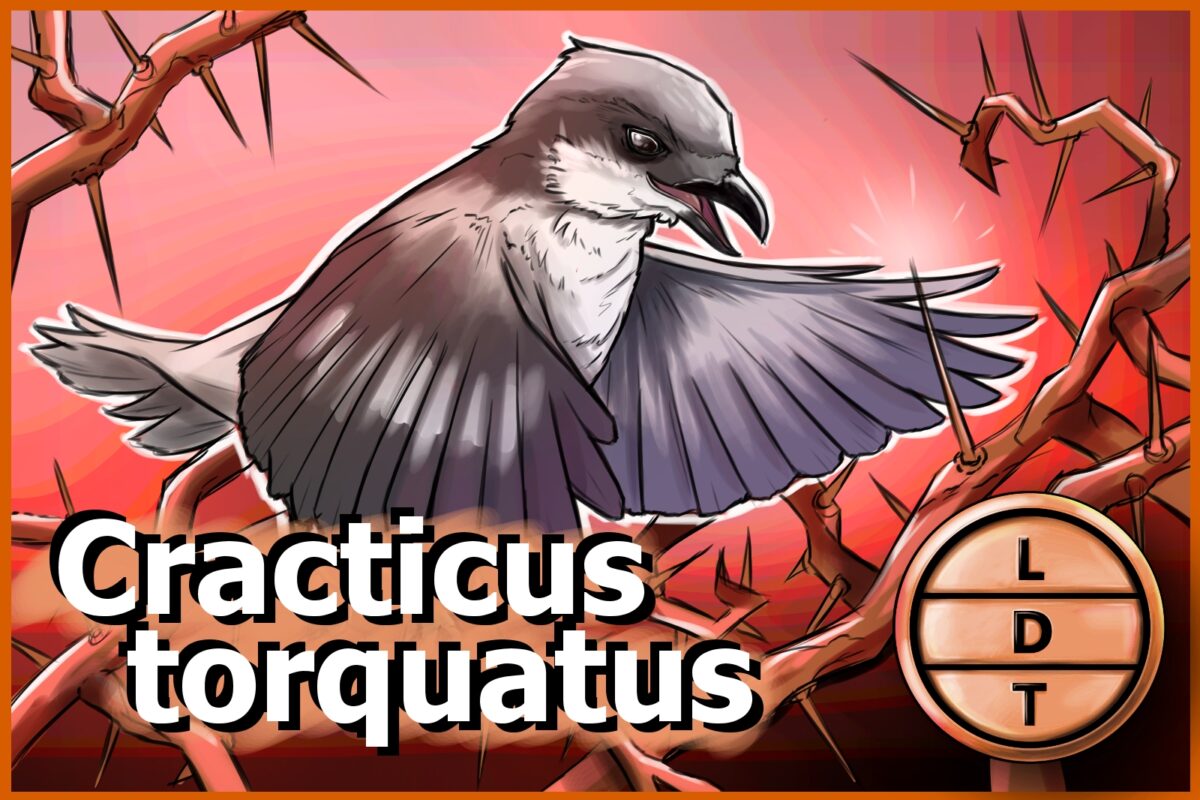“…and today we’re talking about Yennefer of Vengerbird, the black and white songbird downunder. But more on that later.”
If you’re out for a stroll in the wilds of Australia, Europe, or North America, you might stumble upon a peculiar and gruesome sight: the impaled victims of the butcherbird. Setting its sights on larger prey but lacking the strength to subdue it, the butcherbird uses its environment to its advantage when hunting. But, brutal or not, a bird’s gotta do what a bird’s gotta do to survive here in Life, Death, and Taxonomy.
Description
The grey butcherbird has a black head, with a white neck and belly. Their shoulders are a slate grey with black wingtips and tail feathers. Young birds have a dark brown head with white streaks and are said to look a lot like a kingfisher.
They’re shaped kind of like a crow with a proportionally longer beak. The beak also has a distinct hook on the end of it that you wouldn’t see in every passeriform.
Males and females share similar colors but males are slightly larger.
Measure Up
Welcome to the beloved Measure Up segment. The official listener’s favorite part of the show! The part of the show when we present the animal’s size and dimension in relatable terms through a quiz that’s fun for the whole family. It’s also the part of the show that’s introduced by you when you send in audio of yourself saying, singing, or chittering the words Measure Up into ldtaxonomy at gmail dot com. We don’t have a new Measure Up intro this week.
- Common Black Bird
- Malabar Whistling Thrush
- Bahama Mockingbird
- Grey Butcherbird
Wingspan
- They have a body length of up to 30 cm or 11.8 inches and a wingspan between 37–43 cm (14.6-16.9 in).
- How many grey butcherbird wingspans go into the tallest inflatable waterslide?
- Hint: The tallest waterslide ever is called the Hybrid XL and it was made for a pop-up water park in Perth, Australia. It was made by the U.S. based company Freestyle Slides.
- 52.1 wingspans. The slide is 22.4 m (73.4 feet).
Weight
- 90 grams (3.2 oz)
- How many butcherbirds go into a jar of Elvish Honey that you could buy for $6,800?
- Hint: Elvish Honey is natural wild honey that’s produced in a deep cave in Turkey. The cave is said to imbue the honey with special minerals that make the product more expensive than gold.
- 11 butcherbirds. Elvish Honey goes for about $6,800 per kilogram.
Fast Facts
Even though they’re known as butchers, they’re actually very talented singers. They are known to be among the premier songbirds of Australia. Their songs contain both melodious whistles and harsh dissonant sounds.
Each member of a territorial group participates in the same territorial song. They repeat each other’s songs in a given area to let other birds know the territory belongs to their group. Sharing the same song allows the birds to spread a tune farther than if a single bird sang, like lighting the beacons of Gondor.
When a territorial group is performing, birds from other territories shut up and listen. Songs have been recorded lasting as much as 15 minutes. Individual members usually call and respond but sometimes overlap.
The breed in pairs between July and January and both sexes share parenting duties. Both will feed hatchlings and defend the nest but the mother incubates eggs. They may nest in a variety of habitats including woodland, shrublands, rainforests, and even urban areas.
They mostly eat insects and other animals but they’ll sometimes eat seeds. In some cases, they’ll eat other smaller birds and vertebrates.
Major Fact: Penchant for Poking
Butcherbirds are birds that are known for a specific and brutal style of hunting.
They aren’t all related taxonomically though. Many butcherbirds are in the shrike order of birds. I’ve seen the shrikes in South Africa. The ones in Australia, however, are more closely related to magpies.
But butcherbirds of all types practice a common predator hunting method called “sally pouncing”, which involves flying straight into prey, grabbing it with its beak, and flying back to its perch. They’ll mainly go for insects, but they’ll also eat lizards, frogs, and even mice as big as they are.
Lots of birds use the sally pounce, but where raptors have strong legs and talons to grab and carry off prey, the butcherbird has the dainty feet of a passerine, so it needs a different strategy for larger prey.
It will clamp its beak down on the spinal cord of the animal to paralyze it. After that, it will shake the prey around like a dog to break its neck.
Then, they’ll often find a nice, quiet place to impale their prey like a thorn or branch. This acts as a larder, or a place to store food. The butcherbird can come back later to eat and it makes it easier to eat as well. It is also a way for males to attract mates with a scrumptious offering.
So you can tell when a butcherbird is nearby when you see the impaled bodies of its victims on display around thorny bushes. Kinda like a mad-max scene.
Ending: So sally-pounce whenever you get the chance, sing a rollicking duet, and keep your food impaled where you can always find it like the grey butcherbird here in LDT.

